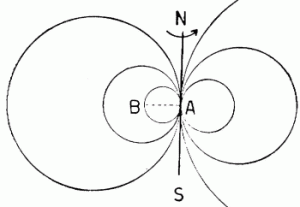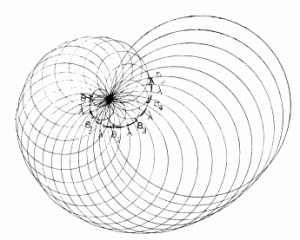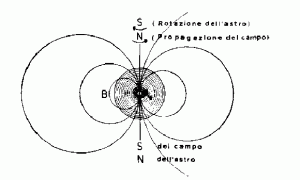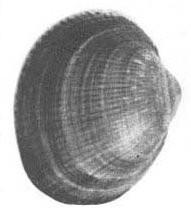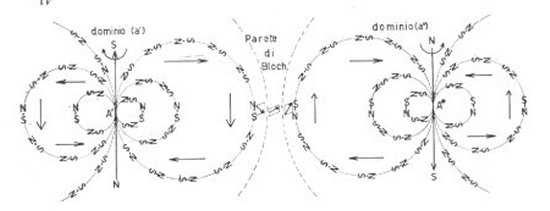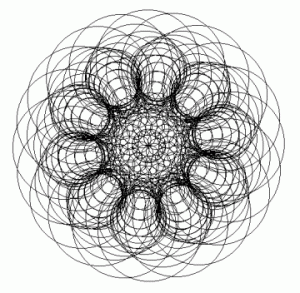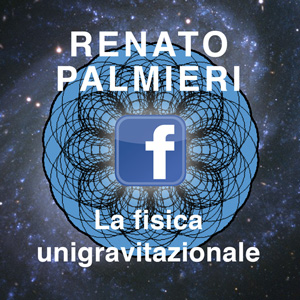Premise.
Recent earthquakes (September-October 1997), that affected the towns of the Appennino in the regions Umbria and Marche, give us the evidence of the inconclusiveness of the contemporary scientism in it’s attempt of giving explanation and making forecasts about phenomena whose true nature and origin are completely ignored. An amount of declarations continuously denied by the evolution of the phenomena and the following quarrels among the different insiders have been the ridiculous result of the tragedy. The problem is always the one we have already reported: the current way of treating the geophysical events (faults, plaques, subsidences, etc.) is, also in this case, purely descriptive – and therefore completely useless, in the absence of whatever real motivation of the magnetic-gravitational kind inside of it.
We united in this composit adjective our concept of the uniqueness of the magnetic and gravitational phenomena, in relation to which we republish the essay: “Magnetism and earthquakes. The prediction of events”.
Hopefully, at the end of reading, geologists and seismologists are following the footsteps of the Japanese quoted in the article, putting under strict magnetometric monitoring the seismic zones, to catch in advance respect to the real earthquakes the geomagnetic anomalies which are the prodromes of them. Or by giving attention to the restlessness of their pets, that have received by nature seismomagnetic organs, suitable to feel those anomalies and putting them on alert before of their distracted masters.
They will be able, in the end, to think again about the huge foolishness suggested to us by the modern geology, according to which the overlap of terrestrial strata magnetically counteroriented would be caused by the continuous inversion of the polarity of the entire magnetic terrestrial field. The same clumsy explanation is given, regarding the Sun, on the polarity reversal of the Sunspots from one cycle to another. The phenomena is actually identical to the one given to the terrestrial strata and is originated by the progressive orientation in time, for antiparallelism caused by mutual interaction of the strata of the fluid matter of the Sun, without any relation with the general polarity of the magnetic field of the Sun, which remains constant. On Earth, for the relative rigidity of the crust, such phenomena is the real reason of the tectonic imbalances and, as a consequence, of the earthquake: it’s only indication is the occurring of abrupt local changes in the magnetic field respect to the standard
October 30, 1997
The following article is taken by:
Tempo nuovo, Naples 1972, nn.1-2: The unigravitational field
MAGNETISM AND EARTHQUAKES. PREDICTION OF EARTHQUAKES by Renato Palmieri.
Being A (fig. 1) the center of mass of a material system, from it are starting spherical gravitational waves, that propagate rotating eccentrically around polar axis NS tangent to A. The poles North and South are identified by the counterclockwise direction of rotation respect to N, clockwise respect to S. The wave rotation is happening on a equatorial plane, orthogonal to the axis NS (fig. 2, where propagation, counterclockwise, is seen by the North).
The gravitational waves of a material system are therefore forming a vortex, in which the external matter is flowing toward the center (“eye” of the vortex) along spiral lines, generally in the opposite direction of the propagation: in fig. 2 the direction of the flow is clockwise. Is resulting that the North pole of the propagation coincides with the South pole of the rotation of the material system and vice versa: fig. 3 is showing the composition of a spheroidal body, with the matter collected in the eye of the vortex, around the center of gravity Ab, and rotating in opposite direction respect to the propagation. Fig. 2 is explaining the centripetal spiral structures of countless natural forms, like shells, cyclones, galaxies, trajectories of meteorites and of particles, microscopic organisms, crystals, etc. The translation along the axis (toward South, as in fig. 1, or toward North) determines the spiral development left-handed or right-handed of other different structures, as in chromosomes, in the disposition of seeds in plants, in horns, elongated shells, tornadoes, etc.
The “quantum” (indivisible particle) of matter is the photon, only component of the universe and responsible electromagnetic phenomena, including light: this is already matter and the macroscopic matter is condensed light. The first associated status of photons, that aggregate forming “bodies”, are detected in comets.
Each material element – simple o complex – is traveling on gravitational waves (along arches and intersections of them) produced by other material elements scattered in direction of the points of emission of the waves, where gravitational intensity is at its maximum. Gravitational waves are emitted by all bodies, continuously, with frequency, length and intensity determined by the composition – following precise laws – between waves of minor system (up to the photons) constituting each body. Frequency, length and intensity that are fundamental and unalterable are those of the photonic field; each complex system has instead multiples propagations of varying frequency, length and intensity in relation to the multiple composition of waves among the elements constituting them. About laws of composition we are going to deal elsewhere; here we are limiting to distinguish gravitational waves in three ranges in decreasing frequency and increasing length and gravitational intensity:
a) electromagnetic ( γ and X rays, light and colors, micro- and radio-waves);
b) mesomagnetic;(…)
c) megamagnetic.(…)
With the instruments now available is not possible to detect the waves of the last two kind because of their low frequency and too long length. The structure of the universe however allows to recognize safely the laws and the effects as analogues, except for the different scale, to those of the electromagnetic waves.
The eccentric rotation of the gravitational propagation is inducing phenomena of “orientation” in the mutual motions of gravitating bodies, in which in facts consists the magnetism.
The matter which is flowing toward the center of a dominating gravitational vortex (“magnetic dominion“) makes this similar to a toothed rotating solid on its equator (reverse to the propagation). Schematizing therefore the two kind of rotation (fig. 4), one axial and one equatorial, the optimal dispositions – without the stiffness of a gear – of two magnetic rules: it’s clear that the polar rotation of two meshing solids is consonant, if moving toward the same direction; the equatorial rotation, instead, to be consonant, must have opposite direction.
The disposition of the gearing on the left is corresponding to the one of two magnets, whose poles are strongly attracting each other. The magnet is in fact a gravitational field uniformed and intensified by the high grade of orientation of the atomic structures: it presents a well characterized polar axis, along which are gravitational lines are thickening (fig. 1 e 3) therefore making collision events more numerous and rapid. This phenomenon becomes macroscopically sensitive in the interaction with substances of similar magnetic structure (iron, nickel, etc.). When we approach the opposite poles of two magnets, the peripheral particles of the two gravitational system are finding themselves channeled with concordant direction toward respective vortices: the parallel flow of the atomic motion in the two bodies is extending and promoting, therefore, the attractive gravitational interactions, between the particles of the contiguous zones, which drag the whole system to which they belong in the fall toward the other system: the two magnets collide. If we approach two equal poles, the peripheral particles of each body orbit in their own atomic structures in a discordant way respect to those of the other body: the interactions are taking place at a too high relative speed, so that the microcosmic gravitational deviation events – or “escape” – prevail far more than those of “collision”. Hence the two magnets, instead of falling one on the other as in the case of opposing poles, are instead “reflected” by the peripheral gravitational deviation events: such is the nature of “revulsion” which is manifesting between the two systems.
The arrangement of the gearing to the right in fig. 4 is corresponding to the one of the two valves of a shellfish lamellibranch, whose shell is representing clearly the structuring of matter inside the lines of two gravitational propagations equatorially congruent. Leaning on a plane the valve of a shellfish from the Veneridi family (fig. 5), placing it with the hinge on the right. Observing that from a “source” point out of the center of the hinge a series of circumferences (such with the approximation of every complex physical structure) are enlarging toward the left and rotating tangentially to the axis of the hinge and visualizing the intersections between the spherical waves of the propagation:
of this the axis of the hinge will show the extreme top the South and inferiorly the North. By the circular contour of the valve will be possible to see many spiral lines converging towards the center of the hinge, signing the trajectory of calcareous matter attracted in the vortex of the propagation: respect to this centripetal motion of the matter – reverse to the one of the waves – the poles of the hinge are inverted, with North above and South below; the flux of matter is then a spiral centripetal one, with a West-East trend, as happening with the terrestrial field and with any other celestial body (rotational motion, incidence of most meteorites and of the primary cosmic radiation, Van Allen bands, galactic spirals). The structure of the valve is faithfully reproducing the shape of a gravitational field or – what is the same – “magnetic”, variable only for the frequency, length of the wave and intensity of the electromagnetic range and those of the meso- and megamagnetic waves. In this regard it is significant to examine that on the outside of a shell is printed the spectrum of the propagation: the converging spiral lines that are delimiting the bands, in which are appearing as “rows” the small arches of circumference of the propagation waves. An other noticeable thing is the transversality of the propagation respect to a radius being originated by the source.
Let’s now consider the mutual position of the to valves. Looking at the double shell by the side of the hinge placed vertically (fig. 6): the two fields result assembled on their equator and in them the matter is flowing toward the umbone in opposite way, being channeled in the hinge as in the right gearing of fig. 4, that is in a concordant way. The poles by the two sides of the hinge are therefore inverted: the axis of the left valve has North above and South at the bottom; vice versa for the right valve. The coordinated flowing of the atomic motions of the two valves toward the furrow of the hinge is stabilizing the gravitational interaction, determining the coupling of the edges along the hinge. The equatorial coupling is also the required condition to have a composition between the two propagations, giving birth to a daughter propagation. The laws of gravitational composition,m so called above, are explaining the origin of life; in the Lamellibranch, the daughter propagation is collecting and organizing the matter of which is formed the animal closed between the two valves. The union of the two equatorially anti-polarizing fields (or anti-parallels) is the reason of all specularly symmetrical biological structures: the example of the bivalve shell immediately suggests the analogue, though immensely more complex, of the two cerebral emispheres, from which the bilateral structure of the entire organism comes.
Stabilized that the optimal positions of two magnetical domains are those of the rotism in fig. 4, we can see how concretely, in its continuous process of gravitational aggregation, matter naturally tends to orient in a manner to vary the least possible from the two preferential positions. The complex spherical geometry of the gravitational field and its dynamism make in fact impossible a total and definitive adjustment of matter in the best conditions of orientation.
We have seen that the gravitational field of any material system results from the composition between between the fields of the minor constituting systems: the elementary field is the photonic and all the others are more or less enlarged copies of it, modified in accordance with particular laws, but whose fundamental shape reproduces the one of photonic field (fig. 1 and 2). Every material aggregate is therefore a gravitational dipole, decomposable in increasingly smaller dipoles. The dipolar structure can be masked by a multiplicity of axes, as we are going to show below. The centripetal thickening of matter exercises a sieving action on all larger and minor dipolar systems. In fact those mutually best oriented, that is less deviating by the two optimal location, are aggregating more easily among them. Those system less oriented compared to those same theoretical position tend instead to escape from each other, as the two magnets that direct the same poles to each other. Therefore the first are mainly catering around the center of mass of the overall system, of whom they constitute the magnetic core; the second are confined mostly in the periphery, that is in fact the area of increased turbulence and instability.
In nature, the concomitant processes of gravitational thickening and of magnetic orientation, go through cyclical phases. The reason is the following.
As long as two material systems are sufficiently distant in relation to their gravitational intensity, their mutual magnetic orientation has scarce influence over their reciprocal gravitational motion. Though, as long as the distance between them decreases, the orientation acquires increasing importance, because – as it has been seen – the reciprocal motion of peripheral particles in each system most of all are affected: the “repulsion” between equal poles of two magnets is in fact macroscopically sensible only below a certain critical distance. As a result, the progressive thickening of matter for gravitational interaction is accomplished through alternated stages, with quiet phases of gradual aggregation, unless the distances between the composing systems remain proportionally large enough, and agitated stages of adjustment (“rotational repulsion”), when the distances irrepressibly exacerbate the local phenomena of “magnetic repulsion” by becoming too short. Every magnetic crisis generates a mixing in the areas affected by the rotational revolt, after that only the well oriented systems continue the aggregation process inside the distances resulting to be critical: the others undergo violent gravitational deflection’ effects and become then marginalized toward the periphery of the system, unless in the upheaval of the crisis they don’t acquire a new position adequately oriented with the others systems. Once appeased the settling phase, which acts as a magnetic “sieve” of matter, a stage of relative quiteness takes over, during which the particular dipoles – best oriented than before the crisis – continue the process of mutual aggregation. However the further decrease of the mutual distances also bring the new orientation – still imperfect – to a critical point and then to a new rotational revolt; and so on for the successive ciclical phases.
The process now described ( gravitational thickening and magnetic orientation) concern every gravitational system: a galaxy or a star, as well as an atom, a molecule or a cell. In a future article we will see the biological corresponding in the process of senescence, with the connected phenomenon of cellular cancer. We can tell strait away that in the sidereal macrocosm it involves the continuous cooling of the system, through periodical phases of magnetic crisis, that provoke a temporary heating of the system itself, with local phenomena of expansion, emission and explosion (volcanism) or instability (earthquakes) of matter.
The cyclical heating of the celestial bodies includes long and short periods: it corresponds, for example, to the phenomenon of the “interglacial” phases, found in the geological history of earth – of which no logical explanation had ever been given until now – and the cyclical resurgence of the solar activity (sunspots and magnetic storms). The protuberances and the sunspots – phenomena respectively volcanic and seismic – drawing with evidence the typical lines of a local gravitational field with eccentric propagation, as it has been revealed in our previous work: the same applies with the “geological cyclones” remained imprinted on earth’s crust since the time of its fluidity, as the spiral in the Alpine circle and of other and of other mountain ranges, the archipelagos with festoons and the submarines ridges of serpentine form.
The analysis carried out so far, lead to an important consequence, which can be at once subjected to an experimental verification. It means in fact that a seismic movement is strictly related to a magnetic crisis and that therefore the study in deep of the local magnetic fields by a dense network of magnetometers can early reveal the magnetic disturbances that signal the onset of the crisis, that is on time to give to the population an early warning of the earthquake itself. Well, such a check has already been made, with most certain results. In an article written by the Japanese Hagiwara and Rikitake for Scienza e Tecnica 69 and entitled “Earthquake prediction”, among the other warning symptoms are quoted (pag. 223-224) – without any scientific identification of the causes – sismomagnetic effects, that is abnormal changes of the geomagnetic field preceding the earthquake, which have been observed since the eighteenth century. Orogenic and tectonic phenomena as bending, fractures, faults and various deformations of the earth’s crust are themselves effects and not primary cause of the earthquakes, and therefore their study should be viewed in the geomagnetic gravitational interpretation for the purposes of an effective prediction of the seismic catastrophes.
The optimal arrangement of two equatorial magnetic domains and of the minor dipoles belonging to the main systems is given in fig. 7, where the straight arrows mark the South of each propagation, those curves mark the circular motion of the waves. The small dipoles are placed in circular chains along the lines corresponding to the maximum polar circumferences of the propagating waves, as in the shell’s valve in fig. 5, with anti-polarized orientation on the equatorial plane compared to the main field. The two domains are separated by a subtle diaphragm (“Bloch Wall”), in which the orientation of the small peripheral dipoles is gradually reversed .
In this manner the maximum possible approximation to the preferential positions in fig. 4 is realized, obtaining the four following results:
a) the two domains (a’) and (a”) are equatorially anti-polarized (“anti-parallels”);
b) the same applies to the small dipoles situated on the equator, respect to its own domain;
c) along each circumference the small dipoles are in nearly axial position among themselves, with adjacent opposite poles;
d) the same applies for the small dipoles located in close proximity to the axis domain, respect to the orientation of this.
There are of course – inevitably, as is has already been seen – some disharmonies: for example between the small dipoles from one to another circumference, and among the small dipoles and the domain in the intermediate positions from the equator to the axis. It is these disharmonies to cause the magnetic crisis, of which we have spoken before, during the process of gravitational thickening of matter. This way, shrinking for this process all the distances in the domains in fig. 7, the equatorial parallelism of the small dipoles and the convergence of their equal poles near the axis at a certain critical moment will cause the mutual “rotational repulsion”, which will break up the two major domains in a different distribution of the minor domains: these will be now represented by the small dipoles united in anti-parallels couples, as before it had been for (a’) e (a”).
It’s now quite clear that the so called “lines of force” of the magnetic field are constitute by circular chains made of small dipoles gravitationally and rotationally bound one to another, and moreover that these lines are not at all symmetrical to the two sides of the axis, as instead appears by their common representation.
We will now make the speech made on the magnetic configuration from fig. 7 experimentally concrete. Let’s now only consider domain (a”), oriented as the gravitational field in fig. 1 and 3. Let’s make correspond to fig. 3 the representation of the Earth with the “lines of force” of its magnetic field. The rotational poles result upside down in the picture, respect to the conventional cartographic use; equally conventional is the verse of the magnetic lines, commonly indicated South→ North along the axis, while in fig. 7 the marked verse is North→ South. Let’s keep in mind, moreover, that the poles are always located by the rotational direction, anti-clockwise respect to North, clockwise respect to South. Let’s now follow with a cardan suspension compass the “lines of force” streaming in the outside of the terrestrial surface: we will see the dipole of the magnetic needle orienting exactly as the small dipoles in fig. 7, with N turned toward the North of the terrestrial rotation corresponding to the magnetic – or gravitational – South and with an angle of “inclination” on the horizon (of 0° on the equator and 90° on the poles). The terrestrial axis is therefore working as a magnetic bar with inverted poles respect to the rotational ones, in accordance with the prediction of our analysis. The magnetic dipole doesn’t do anything else than fitting harmoniously in the invisible chains of small dipoles, represented by the uncountable gravitating particles in the terrestrial field, in the exact configuration of fig. 7. Then, the “declination” of the magnetic needle respect to the axis of rotation depends from what had been said regarding the multiplicity of the propagations of every complex system: such propagations can’t evidently gather around a single axis, but oscillate around a “hourglass” of axes, among which the most important are two: one mega-magnetic, or rotational, and another meso-magnetic, or simply – in the traditional usage – “magnetic axis”. The asymmetry of the “lines of force” from one side to the other of the axis can be easily verified in the magnets, only providing suitable tools for the investigation. It’s a most clear visual effect of the eccentric propagation of the gravitational waves, as in fig. 1 and 2, as well as the spiral trajectories of falling bodies (by the stars to the meteorites and to the smaller particles) inside a dominant – mega-, meso- or electromagnetic – gravitational field.
The natural substances present various chances of orientation of the particular fields around one or more prevailing fields (“dominions“): therefore, depending on the disposition and the width of the magnetic domains, there are different grades of magnetism. Let’s first of all divide the substances in two groups:
1) dis-magnetic: irregularities of the magnetic domains; acrystalline shapes;
2) ortho-magnetic: regularity and complexity of the domains more or less high; crystalline shapes. The crystalline grid results by the symmetry of placement of the lines of gravity of the atoms between them, depending on the particular magnetic orientation that the constitution gives to the intra-and interatomic fields.
Let’s then distinguish the ortho-magnetism for increasing complexity and decreasing width of the domains in para-magnetism and dia-magnetism, and each status in two levels, marked with proto- and deutero-.
The proto-paramagnetism is, for example, the one of non magnetized iron. The deutero-paramagnetism is in turn subdivided, always for increase in complexity and minor width of the domains, in ferromagnetism (magnet), ferrimagnetism (ferrite), anti-ferromagnetismo (as in manganese oxide). The proto-diamagnetism is, for example, the condition of copper or gold. Finally, the deutero-diamagnetism applies in the superconductivity phenomena, superfluidity and Meissner effect, which we will discuss in another work.
The magnetic natural scale therefore includes seven degrees:
1° dismagnetism;
and ortho-magnetism, distinguished in
2° proto-paramagnetism;
and deutero-paramagnetism,
(subdivided in
3° ferro-magnetism
4° ferri-magnetism
5° anti-ferro-magnetism);
6° proto-diamagnetism;
7° deutero-diamagnetism.
About the imaginative character of the existing physical theories, it is curious and significant to observe that the magnetic antiparallelism found in the rocky layers of the Earth’s surface has been absurdly interpreted as the effect of a continuous inversion of the polarity of the geomagnetic field; inversion that would have occured at least twenty times in the past four milions of years. It’s clear instead that the antiparallelism of the strata is not different if not in widht of the dominions from what is found, for example, in the intimate structure of the ferrites and there is no need to manufacture, in order to explain it, the theory of a dancing geomagnetic field. It is the result of a continuous magnetic accomodation of matter in all its parts, of that labor which we have defined “rotational repulsion”, or magnetic crysis, as it is demonstrated by the signs of the impetuous volcanic activity not coincidentally related to the particular condition of orientation of the terrestrial strata. In a future article we will explain the relationship between the magnetic field and internal heat of a star: insoluble problem on the basis of current views, as the temperatures hypothesized for the core this should not manifest its particular magnetic characteristics.

